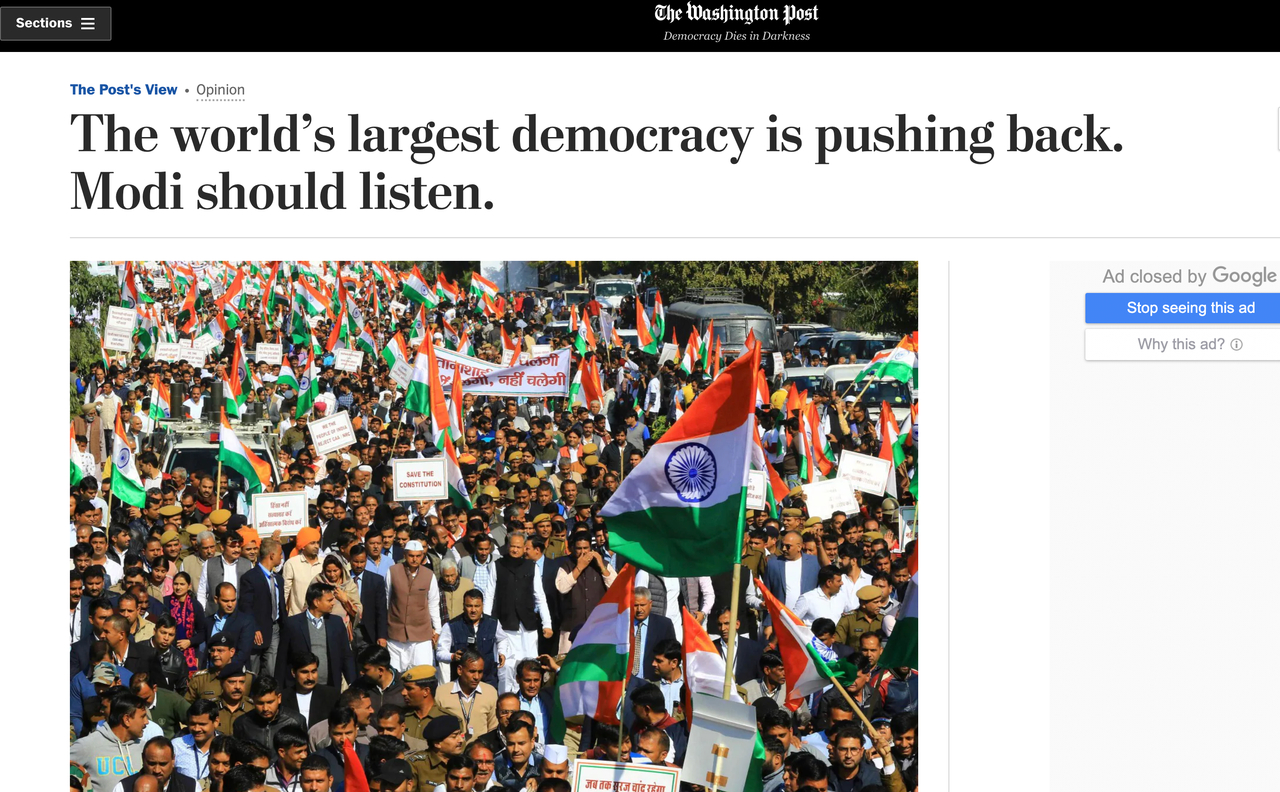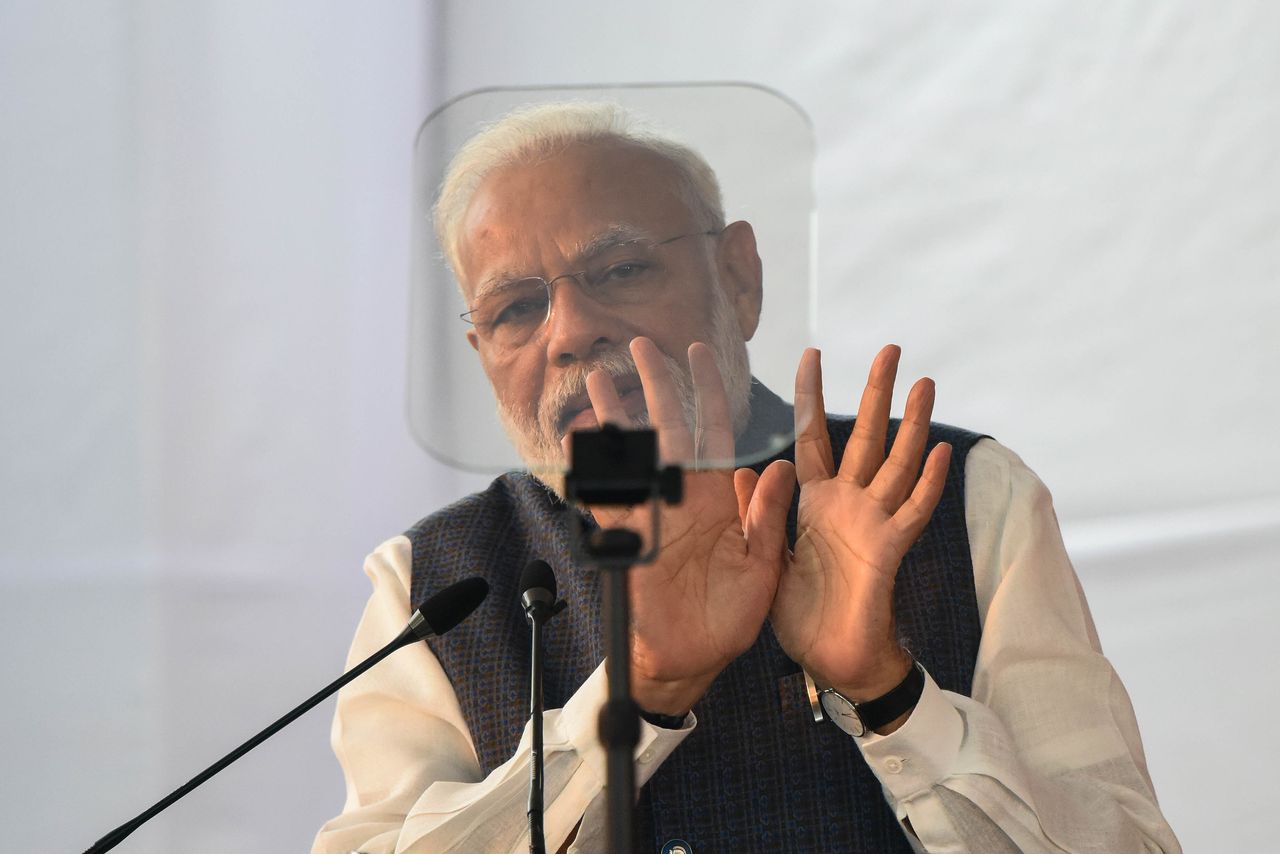When India’s prime minister Narendra Modi first came to power in 2014, international media platforms published long articles where they acknowledged his controversial past but expressed the hope that he would prioritise growth and be wise enough not to be distracted by the Hindu nationalist agenda (see here, here and here). In his first term, as Modi went on long global tours to meet world leaders, western liberal media outlets such as Time and The Economist were generally optimistic that the “global political star” would put the 2002 Gujarat riots and the BJP’s divisive politics behind him.
A lot has changed since then – currently in his second term with an even bigger majority, Modi is grappling with an economic crisis that experts say originated from policies such as demonetisation; protests against his government’s attempts to threaten the citizenship of Muslims; as well as foreign media’s disenchantment with his rule.
While Time called him “India’s Divider In Chief” ahead of the Lok Sabha elections last year, The Economist’s latest cover story says Modi is stoking “divisions in the world’s biggest democracy”.
The Economist tweeted the story with the caption “How India’s prime minister and his party are endangering the world’s biggest democracy”. Discussing the Citizenship Amendment Act (CAA), whose passage in the Parliament has triggered widespread protests, the story said “the scheme looks like the most ambitious step yet in a decades-long project of incitement”.
The story (The Economist’s articles do not have bylines) pointed out how the unrest may actually politically benefit Modi and the ruling Bharatiya Janata Party (BJP):
“The sad truth is that Mr Modi and the BJP are likely to benefit politically by creating divisions over religion and national identity. Such subjects keep the party’s activists and their allies in Hindu-nationalist groups energised—always a boon, given India’s relentless sequence of state elections.”
Such subjects, it went on to say, also distract attention from awkward topics such as the economy. The economy is in a dire state with signs of a slowdown apparent.
After the Supreme Court ruling on Ayodhya, the BJP seems deprived of its favourite cause, The Economist said, adding that “citizenship ruckus appeals to the party for the very same reasons that it has prompted widespread alarm”.
The Economist’s article is only the latest in a series of dispatches from international media that have largely been critical of the Modi government’s intolerance, its shock decision to abrogate Article 370 and the communication blockade in Jammu and Kashmir. The Washington Post’s coverage of these events and the anti-CAA protests, in fact, annoyed the Modi government so much that union ministers snubbed the paper’s owner Jeff Bezos on his recent visit to India.
When Modi came to power in 2014, several commentators (see here and here) in international media pointed to his roots in the right-wing Rashtriya Swayamsevak Sangh (RSS) and remarked that there’s some unease that he may pursue the Hindutva agenda (even before Modi’s landslide victory, The Economist had told its readers it would not be backing him). They, however, remained hopeful that the prime minister would take the chance to revitalise the economy. The New York Times’s editorial in 2014 said:
“Mr. Modi has set very high expectations for economic revival and his government, but he can’t achieve those goals if he exacerbates sectarian divisions, for example, by using divisive rhetoric against Muslims.”
The recent coverage, however, reflects international media’s exasperation with Modi and his government’s policies, as well as the state of the economy. The New York Times, The New Yorker and The Washington Post have all carried articles that have been extremely critical of the Modi government’s push on Kashmir and the CAA. They have extensively covered the lockdown in Kashmir and how security forces have arrested thousands of people.
On October 1, 2019, two months after Article 370 was abrogated, The New York Times published a photo on its front page of people crying in Kashmir and captioned it “Misery Grows in Kashmir”. The 1 October story by Jeffrey Gettleman (with photographs by Atul Loke) documented how the arrests and the lockdown in Kashmir had paralysed the lives of people.
On 9 December, The New Yorker published a long article by Dexter Filkins on the Modi government’s divisive, anti-Muslim policies, calling it “Blood and Soil in Narendra Modi’s India”.
The Washington Post’s editorial on 24 December criticised the government’s response to the protests against the discriminatory citizenship law. “Rather than respond with force and epithets, as he has so far, Mr. Modi would do well to abandon this misguided project of Hindu nationalism, long sought by the prime minister’s Bharatiya Janata Party (BJP),” the editorial said. It also advised Modi and the BJP to “admit the discriminatory citizenship law was a mistake and junk it.”

The change in the tone of coverage began even before the decision on Article 370. Soon after Modi won for the second time, The Washington Post’s editorial called the victory “India’s dangerous landslide”.
“Having campaigned five years ago as an economic moderniser, the charismatic prime minister this year offered a platform of nationalism and sectarianism.” The editorial said that the government pursued an “anti-liberal agenda” and that some journalists critical of the regime were subject to intimidation. It also pointed out that attacks by Hindu extremists on Muslims rose significantly.
Time’s cover story of May 9, 2019, written by Aatish Taseer during the 2019 general election termed Modi “India’s Divider in Chief”. Taseer said that Modi’s economic miracle has failed to materialise and he had also helped “create an atmosphere of poisonous religious nationalism in India”.
In the same issue, Time also published a more optimistic article by Ian Bremmer, calling Modi India’s “best hope for economic reform”, which Modi supporters held up as a badge of honour. A few months later, however, Bremmer admitted that he had changed his opinion.
Writing in December 2019, Bremmer said the prime minister was falling back on identity politics to capture political momentum.
“And after securing reelection, Modi continued leaning his shoulder into Hindu nationalism, while neglecting issues like land reform or reducing trade barriers. As that nationalism has taken a more prominent role in government policy, it has begun directly threatening the country’s constitutionally mandated secular democracy,” he wrote.
Senior journalist Ammu Joseph pointed out that the change in the Western liberal media’s coverage trajectory is not dissimilar to that of many mainstream Indian media outlets or “even some liberals”.
“The economic reforms and development mantra and the launch of various high profile programmes in the early years were obviously seen as positive, and the few lynchings and his silence about them were clearly seen as unfortunate aberrations,” she said in reply to emailed queries.
However, she said, it was the government’s insistence on muzzling Kashmir and threatening Muslim citizenship at a time when crises such as unemployment and inflation stare them in the face that seem to have forced some to finally speak out.
“It is hardly surprising that the government’s focus on these drastic, divisive measures while the economic crisis, unemployment and the rising prices of essential commodities that are adversely affecting people’s lives appeared to be getting no attention has forced at least some to question and even criticise the PM as a leader. There’s a limit to how far charisma and oratory can obscure reality. And I guess the scales have dropped from at least some eyes,” she added.
How has the BJP responded?
The BJP slammed the editorial position of Jeff Bezos-owned The Washington Post, with the party’s foreign affairs in-charge Vijay Chauthaiwala terming it “one-sided, biased, agenda-driven anti-Modi”. During his recent visit to India, Bezos was snubbed by the government, with Union Minister Piyush Goyal saying Amazon hadn’t done India any big favours by announcing an investment of $1 billion.
In November, six months after the Time cover story, the Indian government revoked Taseer’s Overseas Citizenship of India (OCI), which allows NRIs a permanent visa to enter and stay in the country. In Time, Taseer wrote that “it is hard not to feel, given the timing, that I was being punished for what I had written”.
Last year, on Gandhi Jayanti, Modi wrote an op-ed in The New York Times to mark Gandhi’s 150th birth anniversary. The paper’s decision to give space to Modi while Kashmir was still under lockdown had annoyed Twitter users. Several pointed out the biggest irony: the NYT’s front page just a day before that had pointed out the misery faced by Kashmiris.
